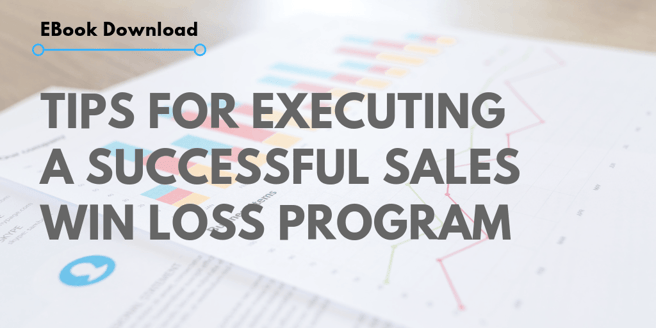In part 1, I shared the insights we believe every company should be striving to capture from the sales process. In part 2, I covered some of the most common methods companies use to acquire those insights, with our strong recommendation that every company implements a Sales Win Loss Program.
In part 3 of our blog series, I will offer our ideal template for conducting a Sales Win Loss Program (which we have acquired through a decade of running these programs for clients) to ensure your company realizes the greatest return on investment from this powerful endeavor.
Key Skills Required Of Your Sales Win Loss Interviewer
The primary objective of a Sales Win Loss Program is to learn everything possible about why your company won or lost, so you can refine your approach and win more deals in the future. With that in mind, the first consideration is – who should be conducting the interviews?
I’ve already cautioned about having the sales representative do it, as the feedback garnered is likely to be incomplete or misleading. It’s always best that the person asking the questions not be too close to the sales process.
Objectivity is vital for a Sales Win Loss Program to be successful. That means an impartial 3rd party conducting the interviews, highlighting the key takeaways, and identifying the themes that emerge over time. The 3rd party can be internal, such as someone from the Customer Experience / Success Team, Marketing, or Sales Operations, but an external consultant with significant experience will be your best bet.
Either way, look for someone who:
- Is an exceptionally strong listener
- Is experienced at interacting with senior level executives, and has an engaging personality
- Understands (or can quickly learn) the sales process – in general and at your organization
- Knows (or can quickly learn) your company’s value proposition, competitive advantages, roadmap, service delivery model, etc.
- Has a good sense of the competitive landscape
- Is skilled at recognizing when something is being glossed over and can probe for deeper insights
- Can be persistent, but knows where to draw the line so as to not pester
- Has the ability to glean, and pinpoint, the drivers of success or failure
- Can convert large quantities of mostly unstructured feedback into actionable findings and recommendations
- Once you have the right person or consulting firm in mind, it’s time to develop the process for your Sales Win Loss Program.
There are some important considerations here, ones that can lead to a program that has a significant impact, or – conversely – dies a slow death.
Sales Win Loss Program Criteria
First, it’s important that the sales team is sold on the program. If your sales reps don’t appreciate the value of the program, or – worse – feel it will be used as a way to single people out when a deal is lost, they can hinder the process. Leadership should work to get the sales team on board with positive messaging about the purpose of the program. (i.e. learning = improvement = win more deals = more $$)
Second, decide on which wins or losses will be targeted for follow-up. It’s unlikely that you will have the resources to put every sales opportunity through the Sales Win Loss Program. Furthermore, many deals likely don’t qualify.
When Satrix Solutions onboards a new client, we generally work with the sales and marketing leaders to establish the criteria to determine which opportunities are targeted. The criteria might include several of the following:
- Deals above a certain revenue or profit threshold
- Deals that you expected to win, but lost – and vice versa
- Deals that were very competitive
- Deals that made it to the latter stages of the sales process
- Deals managed by certain sales reps
- Deals that fall into the ‘ideal customer profile’ group, or certain persona’s that are being targeted
- Deals that originated or were referred by an important partner
- Deals in regions that you are hoping to further penetrate
- Deals that included a new or enhanced product or service
- Deals that are of particular importance to your CEO or Board
- Once your criteria are established, and you’ve set up the mechanism to advise the Sales Win Loss partner on the deals that qualify, it’s time to formulate your “questionnaire” based on what you hope to learn.
Questions to Ask During the Sales Win Loss Interview
Ok, it is not really a questionnaire as much as a list of topics the interviewer will use to guide the discussion. It’s important the conversation stays fluid and somewhat unstructured. If it’s obvious that someone is simply reading from a list of questions, it will surely diminish the value of the exercise.
Additionally, the list of topics / questions should be considered a live document. Meaning that it should change over time, and likely even for each interview. Every sales opportunity is unique, so the focus of each conversation should take that into account. However, most Sales Win Loss interviews will include many or all of the topics I detailed in part 1.
Also, be sure to collaborate with all interested parties internally. The insights that can be elicited from a Sales Win Loss Program can be enlightening to many departments across your organization. In particular, Sales, Marketing, Product, Customer Success, Operations, Support, etc. should all have the opportunity to provide input on what they’d like explored. While you may not be able to get every topic or question in each interview, it’s good to include their input as the more people who are invested in the program, the better.
One last point, the list of topics should also change based on what’s happening inside your company, and across the competitive landscape. Changes in strategy, messaging, your offering, your competitor set, and other developments should lead you to refine and evolve your Sales Win Loss Program.
Key Strategies for a Successful Sales Win Loss Program
Finally, let’s spend a moment on a few tactical elements. Once the criteria are established, there is some consensus on the list of topics, and the process has been largely defined, we ask our clients to share some background details on each opportunity we will be perusing. That might include the RFP response, notes input by the salesperson into Salesforce, a list of known competitors, etc. The more knowledgeable you are going into the interview, the better equipped you will be to navigate the discussion.
Then, it is time to reach out to the contacts and schedule the call. I prefer to email and ask to schedule a 20 to 30-minute call. This gives the person the opportunity to think about the experience with your sales team, and what led them to make their decision. It also enables them to collect feedback from others in their organization, and to review documents to remind themselves of what they liked or didn’t like. Calling them out of the blue can catch them off guard and you may not get as much detail as you would otherwise.
I also prefer to record the phone conversations, rather than furiously scribbling notes while trying to listen carefully and probe. Different states have different requirements and laws for recording phone conversations, so be sure to investigate that before doing so. It’s always safer to ask for permission at the start of each call anyway. And, with more and more privacy laws (like GDPR) in place, you may be required to get consent at the very start of your interview.
In part 4 – our final installment in the series, I discuss the very important analysis, interpretation and actioning phases of your Sales Win Loss Program. Read it here.


